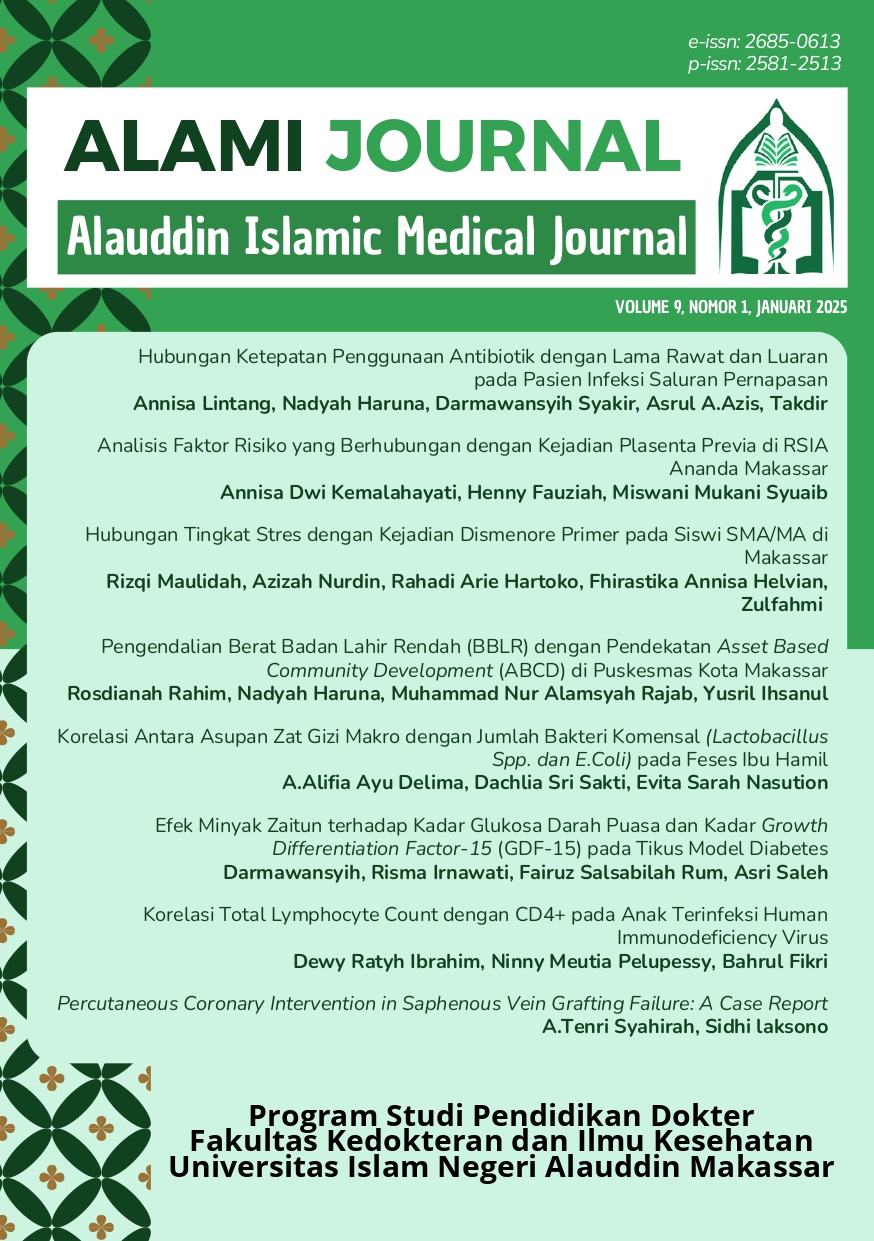Analysis of Risk Factors Associated with Placenta Previa at Ananda Mother and Child Hospital, Makassar
DOI:
https://doi.org/10.24252/alami.v9i1.50848Keywords:
Placenta Previa, Age, Birth Distance, AbortionAbstract
Placenta previa is a pregnancy complication that causes bleeding after 20 weeks. Bleeding is the leading cause of maternal deaths, accounting for 28%, so it is essential to identify risk factors of placenta previa. The purpose of this study is to determine the relationship between maternal age, interdelivery interval, history of caesarean section, and history of abortion with the incidence of placenta previa. This research uses a case-control study with an observational analytic approach. The case group sample was 120 respondents, and the control group was 120. The samples taken were under the inclusion criteria. The research instrument was the mother's medical records at the Ananda Mother and Child Hospital Makassar in 2020-2021. Data were processed with univariate and bivariate tests. Bivariate analysis test results obtained p-value = <0.001 for the relationship between maternal age (OR = 7.828), enter delivery interval (OR = 8.143), history of caesarean section (OR = 4.955) and history of abortion (OR = 3.769), and the incidence of placenta previa. There is a significant relationship between maternal age, interdelivery interval, history of caesarean section, and history of abortion with the incidence of placenta previa at Ananda Mother and Child Hospital Makassar.
References
2. Kemenkes RI. Profil Kesehatan Indonesia 2020. Vol. 48. 2021.
3. Maya L, Indriyani. Hubungan antara paritas dan umur ibu dengan kejadian plasenta previa. Jurnal Obstetrika Scientia. 2020;2(2):127–42.
4. Asih S. Hubungan jarak kehamilan dengan kejadian plasenta previa. Jurnal Ilmiah Obgin. 2019;3(1):110–9.
5. Husain WR, Wagey F, Suparman E. Hubungan kejadian plasenta previa dengan riwayat kehamilan sebelumnya. Jurnal e-CliniC. 2020;8(1):121–30.
6. Eliagita C, Subina P, Oklaini ST, Zulhijjah S. Faktor-faktor yang berhubungan dengan kejadian plasenta previa di Rumah Sakit Umum Daerah Siti Aisyah Kota Lubuklinggau. Midwifery Health Journal. 2019;5(2):89–95.
7. Mursalim NH, Saharuddin S, Nurdin A, Inayah Sari J. Analisis faktor risiko yang berhubungan dengan kejadian plasenta previa. Jurnal Kedokteran. 2021;6(2):100.
8. Sitti D, Een K, Arman. Analisis faktor yang berisiko terhadap kejadian plasenta previa di RSUD Polewali Mandar. Prosiding Seminar Nasional Sinergitas Multidisiplin Ilmu Pengetahuan dan Teknologi. 2020;1(April):164–71.
9. Heryana A. Analisis Data Penelitian Kuantitatif. Penerbit Erlangga, Jakarta. Jakarta: Erlangga; 2021.
10. Barber E, et al. Placenta previa in in vitro fertilization and unassisted pregnancies – is there a difference in perinatal outcomes and placental histology. Human Reproduction Journal. 2022;37(1):520–5.
11. Wahyu H, Febriawati H, Martika Yos, Lina LF. Faktor-faktor yang berhubungan dengan kejadian placenta previa. Jurnal Keperawatan Muhammadiyah Bengkulu. 2019;07(2):114–23.
12. Dippel AL. Placenta previa. Vol. 2, National Center for Biotechnology Information Bookshelf. 2022. 597–602 p.
13. Kaya S, Turhan U, Dağ I, Polat I. Association of maternal serum netrin-1 and netrin-4 levels with placenta accreta spectrum. European Medical Science. 2023;27(10):594–600.
14. Egbe TO, Kobenge FM, Wankie EM. Virginity-sparing management of hematocolpos with imperforate hymen: case report and literature review. Open Medical Case Reports. 2019;7:56–62.
15. Guslatipa D, Sari EP. Hubungan riwayat operasi sesarea, riwayat abortus dan kehamilan kembar dengan kejadian plasenta previa. Jurnal Aisyiyah Mediks. 2020;4:210–21.
16. Suraniningsih. Hubungan riwayat sectio cesarea dengan kejadian plasenta previa. Journal Clinical Obstetric Gynecology. 2020;1(2):86–92.
17. Sugai S, Yamawaki K, Sekizuka T, Haino K, Yoshihara K, Nishijima K. Pathologically diagnosed placenta accreta spectrum without placenta previa: a systematic review and meta-analysis. American Journal of Obstetric and Gynecology. 2023;5(8):76–82.
18. Maged AM, et al. Diagnostic accuracy of ultrasound in the diagnosis of placenta accreta spectrum: systematic review and meta-analysis. BMC Pregnancy and Childbirth. 2023;23(1):1–17.
19. Wang Y, et al. Risk prediction of placenta previa based on the distance from the lower edge of the gestational sac to the internal servical os in early pregnancy. Ginekologia Polska. 2023;2(1): 7–9.
20. Farladansky-Gershnabel S, et al. Low lying placenta: natural course, clinical data, complications and a new model for early prediction of persistency. Journal of Maternal-Fetal and Neonatal Medicine. 2023;36(1):101–15.
Downloads
Published
How to Cite
Issue
Section
License
Copyright (c) 2025 Annisa Dwi Kemalahayati, Henny Fauziah, Miswani Mukani Syuaib

This work is licensed under a Creative Commons Attribution-NonCommercial-ShareAlike 4.0 International License.
Once an article was published in the journal, the author(s) are: granted to the journal right licensed under Creative Commons License Attribution that allows others to share the work with an acknowledgement of the work's authorship. permitted to publish their work online in third parties as it can lead wider dissemination of the work. continue to be the copyright owner and allow the journal to publish the article with the CC BY-NC-SA license receiving a DOI (Digital Object Identifier) of the work.







1.png)


1.png)


.png)
.png)


